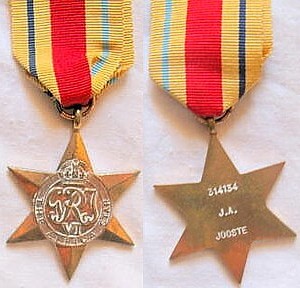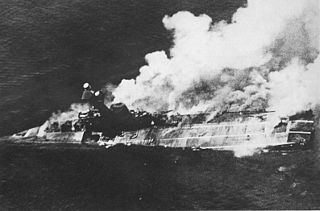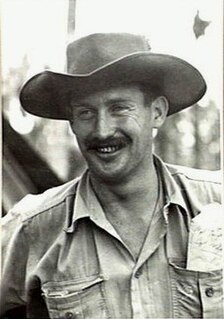
The Africa Star is a military campaign medal, instituted by the United Kingdom on 8 July 1943 for award to British and Commonwealth forces who served in North Africa between 10 June 1940 and 12 May 1943 during the Second World War.
Battle Honours are awarded by the Sovereign to Royal Air Force squadrons to commemorate the squadron's role in a particular operation.

Unit Colour Patches identify the wearer as belonging to a military formation or unit.

No. 8 Squadron was an Australian flying training squadron of World War I and medium bomber squadron of World War II. The squadron was formed in England in October 1917 as part of the Australian Flying Corps, and disbanded in April 1919. It was re-formed by the Royal Australian Air Force in September 1939. After seeing action during the Pacific War flying Lockheed Hudson and, later, DAF Beaufort bombers, the squadron was disbanded a second time in January 1946.

New Guinea Force was a military command unit for Australian and native troops from the Territories of Papua and New Guinea serving in the New Guinea campaign during World War II. Formed in April 1942, when the Australian First Army was formed from the Australian I Corps after it returned from the Middle East, it was responsible for planning and directing all operations within the territory up until October 1944. General Headquarters Southwest Pacific Area Operational Instruction No.7 of 25 May 1942, issued by Commander-Allied-Forces, General Douglas MacArthur, placed all Australian and US Army, Air Force and Navy Forces in the Port Moresby Area under the control of New Guinea Force. Over the course of its existence, New Guinea Force was commanded by some of the Australian Army's most notable commanders, including Sydney Rowell, Sir Edmund Herring and Sir Leslie Morshead.

Prior to World War II, the Indian Ocean was an important maritime trade route between European nations and their colonial territories in East Africa, the Arabian Peninsula, British India, Indochina, the East Indies (Indonesia), and Australia for a long time. Naval presence was dominated by the Royal Navy Eastern Fleet and the Royal Australian Navy as World War II began, with a major portion of the Royal Netherlands Navy operating in the Dutch East Indies and the Red Sea Flotilla of the Italian Regia Marina operating from Massawa.

Military aircraft insignia are insignia applied to military aircraft to identify the nation or branch of military service to which the aircraft belongs. Many insignia are in the form of a circular roundel or modified roundel; other shapes such as stars, crosses, squares, or triangles are also used.

Leslie Douglas (Les) Jackson, DFC & Bar was an Australian fighter ace of World War II, credited with five aerial victories. Born in Brisbane, he was a businessman when he joined the Royal Australian Air Force (RAAF) Reserve in 1937. Called up for active duty shortly after the outbreak of war in September 1939, he served with No. 23 Squadron in Australia before posting to the South West Pacific theatre with No. 21 Squadron in Singapore. In March 1942 he joined No. 75 Squadron in Port Moresby, New Guinea, flying P-40 Kittyhawks under the command of his eldest brother, John. During the ensuing Battle of Port Moresby, Les shot down four Japanese aircraft.

The following battle honours were awarded to units of the British Army and the armies of British India and the Dominions of the British Empire. From their institution until the end of the Second World War, awards were made by, or in consultation with, the British government, but, since 1945, the individual countries of the former British Empire have awarded battle honours to their forces independently.
The 11th Air Squadron was flying unit of the Imperial Japanese Army Air Service. The unit was established on 31 August 1938 at Harbin, Manchuria. The unit saw service in Manchuria during the Manchuria Incident, China during the Second Sino-Japanese War and Burma, Netherlands East Indies, Indochina, Rabaul, Solomon Islands, New Guinea, Philippines, Formosa and Japan during World War II. The unit was disbanded at Takahagi, Japan in late 1945.

Ships and units of the Royal Australian Navy have received numerous battle honours throughout the navy's history.
Bismark Convoy Smashed! is a 1943 Australian documentary film about the Battle of the Bismarck Sea on 2–3 March resulting in the claimed destruction of 22 Japanese ships, their crews and 15,000 soldiers. Actual Japanese losses were rather less, but still devastating.

Central Area Command was one of several geographically based commands raised by the Royal Australian Air Force (RAAF) during World War II. It was formed in March 1940, and covered the central portion of New South Wales. Headquartered at Sydney, Central Area Command was responsible for air defence, aerial reconnaissance and protection of the sea lanes within its boundaries. It was disbanded in August 1941 and control of its units taken over by other RAAF formations. Proposals in 1943–44 to raise a new Central Area Command did not come to fruition.
This page is based on this
Wikipedia article Text is available under the
CC BY-SA 4.0 license; additional terms may apply.
Images, videos and audio are available under their respective licenses.









